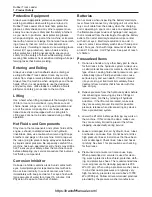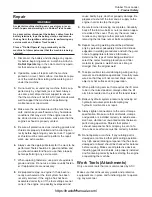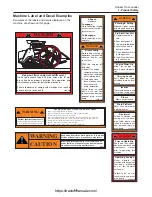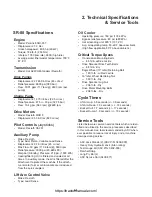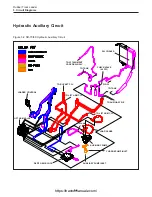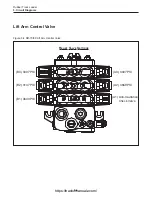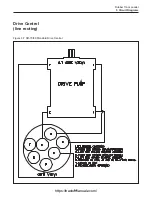
Protective Equipment
Always wear appropriate protective equipment for
working conditions when working on or around a
Rubber Track Loader. Wear hard hats, protective
glasses, safety shoes and any other equipment nec-
essary to ensure your safety and the safety of others
as you work. In particular, wear protective glasses
when pounding on any part of the machine or its work
tool with a hammer or sledge. Do not wear loose cloth-
ing or jewelry that can catch on components and
cause injury. If welding is required, use welding gloves,
helmet (UV eye protection), apron, boots and any
other protective clothing necessary to ensure your
safety and the safety of others while welding. Avoid
wearing flammable or heat sensitive clothing while per-
forming tasks that involve welding.
Entering and Exiting
Always use steps and handholds when entering or
exiting a Rubber Track Loader. Clean any mud or
debris from steps or work platforms before using them.
Always face the machine when using steps and hand-
holds. When it is not possible to use the designed
entry/exit system, utilize ladders, scaffolds, or work
platforms to safely gain access to the machine.
Lifting
Use a hoist when lifting components that weigh 23 kg
(50 Ib) or more, to avoid back injury. Make sure all
chains, hooks, slings, etc., are in good condition and
are of the correct capacity. Be sure hooks are posi-
tioned correctly and equipped with a spring latch.
Lifting eyes are not to be side loaded during a lifting
operation.
Hot Fluids and Components
Stay clear of hot components and system fluids of the
engine, exhaust, radiator/oil cooler and hydraulic
lines/tubes. Also, use caution when removing fill caps,
breathers and plugs on the machine. Hold a rag over
the cap or plug to prevent being sprayed or splashed
by liquids under pressure. Be especially careful if the
machine has been operated recently, fluids may still be
hot. To ensure your safety, allow the machine to cool
before attempting any service procedure that involves
hot fluids or components.
Corrosion Inhibitor
Corrosion inhibitor contains alkali. Avoid contact with
eyes. Avoid prolonged or repeated contact with skin.
Do not take internally. In case of contact, wash skin
immediately with soap and water. For eyes, flush with
large amounts of water for at least 15 minutes. Call
Physician. Keep out of reach of children.
Batteries
Do not smoke when inspecting the battery electrolyte
level. Never disconnect any charging unit circuit or bat-
tery circuit cable from the battery when the charging
unit is operating. A spark can cause an explosion from
the flammable vapor mixture of hydrogen and oxygen
that is released from the electrolyte through the battery
outlets. Do not let electrolyte solution make contact
with skin or eyes. Electrolyte solution is an acid. In
case of contact, immediately wash skin with soap and
water. For eyes, flush with large amounts of water for
at least 15 minutes. Call Physician. Keep out of reach
of children.
Pressurized Items
1.
Do not use hands or any other body part to check
for fluid leaks in the hydraulic system. Always use
a solid material like wood or metal to check for this
type of leak. Leaking fluid under pressure can pen-
etrate body tissue. Fluid penetration can cause
serious injury and even death. If fluid is injected
into your skin, get treatment immediately. Seek
treatment from a doctor that is familiar with this
type of injury.
2.
Relieve pressure from the hydraulic system before
disconnecting or removing any lines, fittings or
related items. Do this by relaxing all hydraulic
actuators. If the lift arms are raised, make sure
they are securely braced. Be alert for possible
pressure release when disconnecting any device
from a pressurized system.
3.
Lower the lift arms before performing any work on
the machine. If this cannot be done, make sure
they are securely braced to prevent them from
dropping unexpectedly during service.
4.
Loose or damaged fuel, oil, hydraulic, lines, tubes
and hoses can cause fires. Do not bend or strike
high pressure lines or install ones that have been
bent or damaged. Check lines, tubes and hoses
carefully. See item 1 for precautions on checking
for fluid leaks.
5.
Pressurized air or water can also cause injury.
When pressurized air or water is used for clean-
ing, wear a protective face shield, protective cloth-
ing, and protective shoes. The recommended max-
imum air pressure for cleaning purposes is 205
kPa (30 psi). When using a pressure washer, keep
in mind that nozzle pressures are typically very
high. Generally, pressures are well above 13790
kPa (2000 psi). Follow all recommended practices
provided by the pressure washer manufacturer.
1-2
Rubber Track Loader
1. Product Safety
https://tractormanualz.com/
Summary of Contents for ASV SR70
Page 5: ...IV https tractormanualz com...
Page 11: ...1 6 https tractormanualz com...
Page 41: ...4 20 https tractormanualz com...
Page 87: ...12 8 https tractormanualz com...
Page 105: ...14 6 https tractormanualz com...
Page 109: ...15 4 https tractormanualz com...
Page 125: ...16 16 https tractormanualz com...
Page 133: ...17 8 https tractormanualz com...
Page 137: ...18 4 https tractormanualz com...
Page 139: ...19 2 https tractormanualz com...







